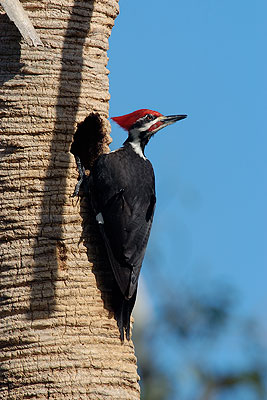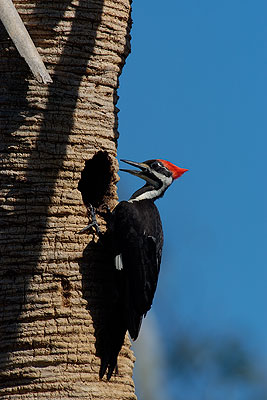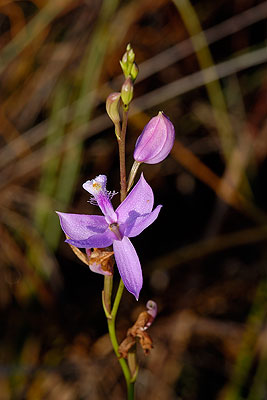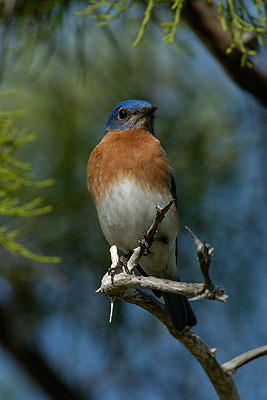
|
News from the Everglades
A Weekly Update from Everglades Imagery April 17, 2005 The ExperienceThis week I had a pretty wide range of experiences and covered a lot of ground. Monday afternoon I photographed at a Pileated Woodpecker nest and got some great images of the birds cleaning out their nest cavity. Tuesday I went chasing sparrows again, but instead ended up focusing on macro. That evening I explored the coastal prairie just to the west of Flamingo. Wednesday I did a little bit more exploring outside the park and found a field full of workers harvesting green beans. Thursday I showed a birder from Belgium around the Everglades and Big Cypress Swamp. We traveled from Miami as far west as Fakahatchee and back. We saw lots of birds and were able to see the northern part of the Everglades as well as Big Cypress. This weekend I have had some visitors from Orlando and on Saturday we went out on an airboat into Water Conservation Area 3B. It was a fun week and I got a wide range of images. See below for an image from nearly every day. The Photos
I was fortunate enough to find this nest late last week and spend some time photographing it early this week. Both birds spent time in the cavity while I was there but only the female did any clearing. As she was in the cavity, I could hear drumming and then after a few minutes her head would pop out and her beak would be full of sawdust. It was an amazing behavior to watch and I was thrilled to get a couple photographs of it. These two portraits illustrate the male (left) and the female (right). Notice the bright red chinstrap on the male bird. These odd shaped plants look like they should be found in a desert or other extremely dry environment. They are very succulent plants, similar to cacti, that are able to control their water input and output. In the coastal prairie they cover the ground and grow to a height of about three feet. They are very dense and cover huge prairies. This particular image shows the leaves of one of these plants and each leaf is approximately a half inch long. I mentioned a couple weeks ago that I was struggling with getting these beautiful orchids to render correctly in my camera. These flowers are normally bright pink but my camera renders them a purple or violet. My theory was that the camera is able to see and capture part of the ultraviolet spectrum that our eyes can not see, resulting in a blue shift. By photographing these orchids a few minutes after sunrise I was able to take advantage of the atmosphere’s ability to scatter, or effectively filter away, the blue end of the spectrum. This means that we see the warm oranges and reds and results in our beautiful sunsets and sunrises. Utilizing this fact, I was able to capture a much pinker image although it is still not quite representative of what I see, but it is much closer. The morning I photographed the orchid and other macro subjects I also found this beautiful butterfly. When I first stumbled across it, it was covered in dew and had its wings folded (see weblog on 4/12 for image). After I photographed it for nearly twenty minutes it finally had dried off enough to open its wings and fly away. It perched briefly on a nearby blade of grass and I was able to snap these quick images and then it flew off. For my first attempt at butterfly photography I was thrilled with the results. One morning I spent a fair amount of time exploring one of the local cypress domes where I often stop. This morning I was thrilled to find this snake skin wrapped around a cypress tree. I don’t know if it is there naturally or if it was placed there by a person but it was a beautiful situation. In this image I really wanted to play with the textures of the different surfaces. It is almost a monochrome image except for the green fern which gives it a tad of life which I really like. Over the past few decades, many of the pineland bird species found in the national park have disappeared. This includes Eastern Bluebird, Red-cockaded Woodpecker, Hairy Woodpecker, and Brown-headed Nuthatch. Several of these species have been reintroduced and are now regularly seen throughout the Long Pine Key area. I have also found a resident population of bluebirds at the Kirby Storter boardwalk in Big Cypress National Preserve. They hunt for insects in the trees lining the parking lot and into the nearby prairie. Thursday was the first time I was able to photograph them but was happy with the result. I would like to get a few more images but won’t have a chance to get back over there for a couple weeks. For my strange image of the week I bring you this image. I spent about thirty minutes photographing a Black-crowned Night Heron along Loop Road on Thursday and it allowed me to get as close as I wanted. After photographing some traditional and not so traditional portraits I saw this foot gripping the branch right next to a bromeliad. Something about the lines really grabbed me and I tried to make an image out of it. I am not so sure how I feel about it now but thought I would offer it up to everyone else. Any opinions? Send me an email or post in the forums and we can try and get a discussion going.
|








